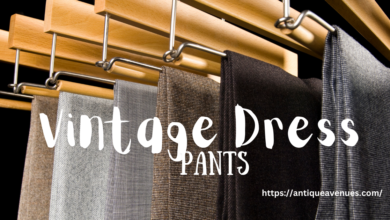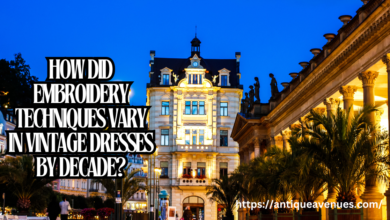What are vintage lace dresses?

The magnificent lace materials that were popular in the past and frequently showed the fashions, craftsmanship, and trends of the day were applied to produce vintage lace dresses. These dresses stand out for their universal elegance, and each one has a unique flair thanks to their exceptional craftsmanship and creative lacework. Most “vintage” goods are between two and thirty years old. These gowns may represent a particular fashion decade and evoke romanticism.
The term “vintage” in the fashion business describes apparel and accessories preserved and used for later events. It honors the everlasting appeal of traditional designs and supports preservation by using old apparel. A piece of antique furniture frequently reflects the materials, production techniques, and aesthetics of the era in which it was made.
Characteristics of Vintage Lace Dresses

The vintage lace gowns are extremely expensive due to their superior quality, classic attractiveness, and capacity to evoke the fashion of the time in which they were created. They are listed here with their unique profiles, textiles, textures, patterns, and concepts, and the way current events impacted each of these elements.
Design and Patterns
Popular Patterns Used in Vintage Lace
The majority of the things that sets vintage lace dresses apart are their elegant designs. Depending on the time and location of origin, these patterns vary. Common patterns include:
- Floral Motifs: The floral lace designs, which were colored by nature, were frequently utilized to evoke romance and femininity. The vines, roses, and sunflowers were most popular.
- Geometric Designs: The modern era and sophistication were reflected in the symmetrical patterns and clean lines of the Art Deco period aforementioned.
- Scrollwork and Paisley: Most used in Classical and Edwardian lace designs, these intricate patterns offered an expensive touch.
Handcrafted vs. Machine-Made Lace in Historical Contexts
The majority of the lace was made by hand, with spool and needle lace being the most typical traditional techniques for making it. The time-consuming, handmade lace was commonly employed to signify exclusivity and improvements. Machine-made laces became widely available with the start of the revolution in industry, making complex designs more affordable.
Fabrics and Textures
Types of Fabric Used as a Base
The general look and feel of vintage lace gowns are significantly influenced by the foundation fabric chosen. The materials frequently used include:
- Silk: Known for its luxurious sheen and smooth finish, silk added elegance to vintage lace creations.
- Cotton: A reasonable and beautiful alternative, cotton-based lace costumes usually featured organic shapes that made them cozy and breathable.
- Satin: The delicate features of lace were enhanced by the shiny sparkle of a satin finish, commonly used for formal and cocktail attire
Soft, Intricate Textures That Define the Vintage Aesthetic
The wonderful, delicate textures of the ancient lace gowns, which are the result of laborious craftsmanship, have made them famous. The elaborate patterns and delicate surface of the lace collectively created an attractive and eye-catching design. Their softly worn texture improves their appealing qualities and lends each piece a unique personality.
Tips for Identifying Authentic Vintage Lace Dresses
Material and Construction
How to Evaluate the Quality of Lace
The real vintage lace usually shows elaborate workmanship and distinctive designs that can be difficult to duplicate. The uniformity and thickness in the eyelet to assess quality. The small flaws that set handmade lace apart from machine-made lace are common. Natural fibers, like cotton, which seem cozier and more organic than present synthetic materials, might have been used to make prehistoric lace.
Identifying Signs of Age and Authenticity
The patina of age, such as little darkening and fading from exposure over time, is a sign of genuineness. Hand-stitching on the hems and seams is a sign of pre-mass production methods. The vintage dresses frequently display evidence of wear related to use, so look for wear in places like the hems and the underarms. The piece’s style, lace type, and any labels or tags that go with it can all be used to identify its period.
Labels and Brand Heritage
Recognizing Vintage Designer Labels
Designer labels from certain eras are key indicators of a dress’s authenticity and value. Research major fashion houses or local designers from the period of your piece. The labels that seem too immaculate for the account of the date with the dress’s age should be avoided since they can be copies. The legitimacy of it can be verified by comparing the label’s language and framework with popular samples from the period.
The Role of Provenance in Historical Significance
The source of a dress—its origin and place of origin—is crucial in establishing its significance. A higher cultural and financial worth is frequently attributed to dresses that have proven ownership and ties to a significant figure and occasion. The provenance is a crucial consideration in the evaluation, as buyers may also look for items associated with particular fashion movements and crucial cultural events.
Care and Preservation of Vintage Lace Dresses

Cleaning and Storage
Gentle Methods for Cleaning Delicate Lace
The beautiful designs and precious threads, the old lace, need to be carefully handled. The washing of hands with lukewarm water and a mild detergent intended especially for delicate fabrics is the best approach. The aggressive rubbing and wringing might strain the fibers, and softly submerge the clothing. The fresh, soft towel is to gently press out the water that remains after washing.
Proper Storage Techniques to Prevent Damage
The vintage lace clothing must be stored properly to ensure its lifespan. The fragile fabric from deteriorating and losing its color should be kept out of direct sunlight and in a cool, dry place. The barrier that keeps water and dirt out uses paper or acid to line boxes of storage and drawers.
Conclusion
The antique lace gowns are prized for their classic elegance, exquisite production, and elaborate patterns that arouse romantic feelings. These distinctive outfits serve as memorable symbols of fashion from earlier times, in addition to being a testament to exceptional creativity. Their beauty and solidity of the structure, proper care, and upkeep have been mild ways to clean to expert restoration when necessary.
A rare opportunity to engage with the creativity and culture of these beautiful clothes is being provided by investigating vintage lace fashion. The whole thing conveys a tale with classic elegance and sophistication, from their delicate textures to their elaborate designs.




One Comment